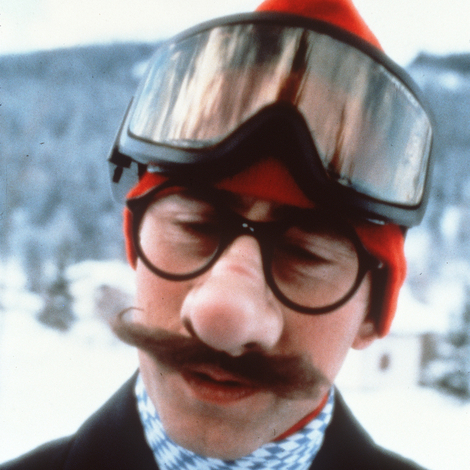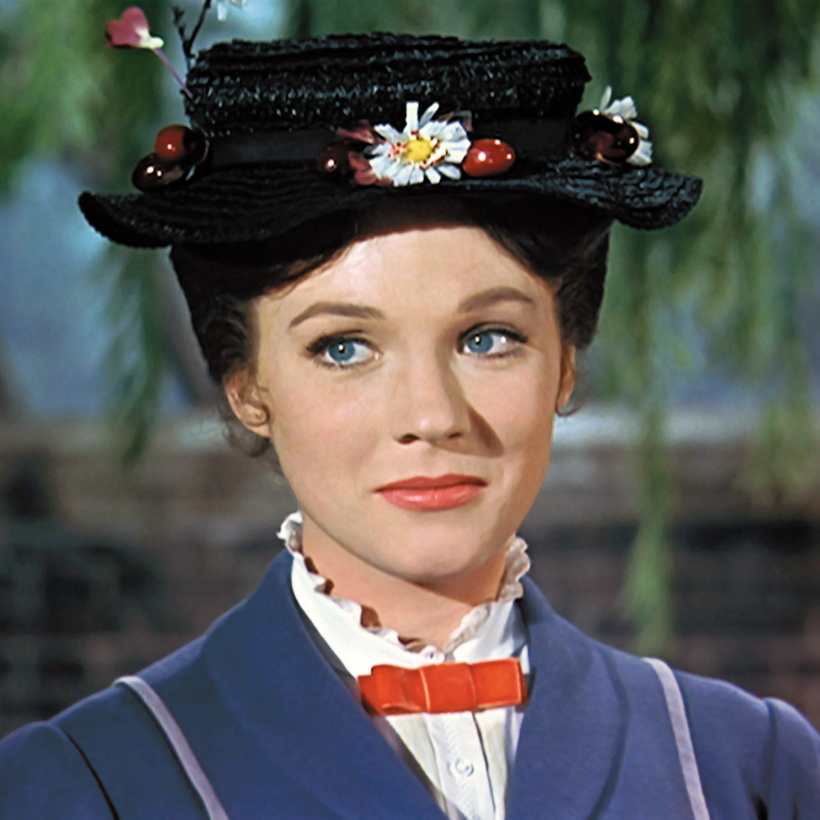In the early 1960s, Walt Disney worked with the Sherman brothers, Bob and Dick, to develop the Mary Poppins stories into material for the screen. As Disney and the brothers, along with story artist Don DaGradi, settled on plot material, their attention turned to a possible cast.
At one point, Disney had considered Bette Davis for the lead role. He had also considered the Broadway actress Mary Martin, known for her stage roles in South Pacific, The Sound of Music, and Peter Pan, but she turned him down. Disney and the Shermans understood that the selection of the right actress was crucial, as that would determine, to some extent, how songs and dialogue would be phrased and presented. The search remained wide open, with the team looking for exactly the right actress to play the quirky English nanny.
One night, while Dick Sherman was watching The Ed Sullivan Show on TV, he saw a British stage actress, dressed in a medieval gown and crown, promoting her current Broadway production, Camelot. “Julie Andrews was there,” Dick said, “with Richard Burton singing ‘What Do the Simple Folk Do?’”

As an actress, she was largely known for her work on the stage, particularly as Eliza Doolittle in the long-running production of My Fair Lady, and aside from a couple of television projects, she had not worked in Hollywood at all. On TV, she sang beautifully, spoke formally, and in a short section of the song even whistled with perfect pitch.
There was nothing unusual about a Broadway actress on live TV, as in the 1960s, much live TV originated from the Big Apple, and various shows, including Ed Sullivan, had a long tradition of featuring Broadway talent. But this performance caught Dick’s attention: the way she spoke, her gestures and posture, the kind firmness that defined her character. In this, Dick started to see her as Mary Poppins.
When the show was over, he called his brother, Bob Sherman. “Have you seen—?” he began, but before he could finish, Bob said he had. By sheer coincidence, he, too, had been watching Andrews’s performance on Ed Sullivan.
The next day the Shermans talked with producer Bill Walsh and DaGradi about Julie Andrews for the lead, only to find that both of them had seen her performance, as well. They were convinced that Andrews would be ideal and wanted to tell Walt Disney, but Disney’s secretary Tommie Wilck convinced them to take a different approach. “Let him discover it,” Wilck advised, “because he doesn’t like to be told.”
From there the group arrived at a plan whereby Wilck arranged for Disney to see Camelot while in New York later that month. They were all hopeful that once he saw Andrews on stage singing the same song, he, too, would think that she was perfect for the role. More importantly, he would think the idea was his own.
Later that week, Disney was in New York, watching Andrews as Queen Guinevere on stage at the Majestic Theater. Once the performance was over, he walked to her dressing room, where she was relaxing with her husband, set and costume designer Tony Walton. Disney complimented her performance and said he was interested in possibly casting her for the role of Poppins. He then explained how the film version, as a musical, would differ from the well-known books. “He was very demonstrative,” Andrews said. “He started acting the whole of the script of Mary Poppins right there, in that small little room.”
For months, Andrews had hoped that Jack Warner over at Warner Bros. would invite her to play the female lead in the film version of My Fair Lady, a role she had developed for years on stage. Beyond this, she had one more immediate reservation about playing Poppins. “I told [Disney] that I was newly pregnant,” Andrews said, “thinking it would negate any possibility of my taking the job.”
Disney simply absorbed the news. He understood that this could delay production by many months, but he was undeterred. “That’s OK,” he said. “We’ll wait.”

Beyond her pregnancy and how she wanted to arrange her time as a new mother, Andrews faced another large question: Did she want to work in film at all, particularly in a role developed specifically for the screen rather than one that she adapted from her work onstage? “I must confess,” she said, “I was very nervous.” But she agreed to visit the studio and further discuss the possibility.
In the weeks before she flew to California, Andrews learned that Jack Warner had hired Audrey Hepburn for My Fair Lady, replacing Andrews in the role she had perfected on stage. “At that time, Julie found out what had happened with My Fair Lady,” Walsh explained, “so she said, ‘the hell with it.’”
At the studio, Andrews did a screen test, complete with makeup and a loosely assembled costume. Disney watched it for only a few minutes before he turned to Walsh and said, “We’re home!”
In the presentation room, DaGradi and Walsh explained the story of Mary Poppins to Andrews. The Sherman brothers also played the music they’d created for the film. Everyone knew what was at stake, the Shermans explained, “when Julie Andrews came out to see the storyboards to [decide] if she would commit to the film or not.”
Andrews immediately recognized the musical style as similar to songs her parents had enjoyed, both at home and in performance. “My background, my early years, were all in music hall and vaudeville,” she said. “My stepfather sang, my mother played the piano for him, and so I had the opportunity to stand in the wings and watch thousands of wonderful performers—vaudevillians and comedians and acrobats. So, when I saw the sort of ‘rum-tee-tum’ quality of the music, it appealed instantly. I kept thinking, Yes, I recognize that. Maybe I could bring something to it that would connect.”

She enjoyed all the songs, except one. Early in the story was a ballad called “The Eyes of Love,” in which Poppins explains her life’s philosophy: until people viewed the world through their heart, they would never see true beauty. Since composing it, the Shermans had come to believe it would be one of the standout songs in the picture. “We thought that was our magnum opus,” Dick said. “That was our great one.”
But as Andrews saw it, the song had no nuance: it literally explained the theme without whimsy or complexity, that love was necessary to find happiness. “Andrews thought the song we had was too direct,” Bob said. “She felt that Mary Poppins wouldn’t say things directly.” Beyond that, she felt the tone and tempo were too drab and slow for a plucky, subversive character like Poppins. Andrews thought the character of Poppins in the books was “very stiff.” To counterbalance this, she wanted to “mix a bit of warmth” and spontaneity into the character.

After she explained her concerns, Disney took the Shermans aside. “She wants a peppy song that’s a keynote song,” he said. He also suggested that a song with a simile or a slogan might be more in line with how the character expressed herself. “Try to write something,” Disney added, “more in keeping with the way Mary Poppins would feel.”
They came up with a lot of possibilities. “But they stunk,” Dick said. “It was impossible. . . . We were going crazy.” The task, as they understood it, was to disguise the message of the movie inside colorful language, only they couldn’t find the words to convey Poppins’s philosophy with pep and precision. “I went home depressed,” Bob said. “[And Dick] went home depressed.”
It was at home, surprisingly, where Bob was presented with the answer.
One day Bob’s son, Jeff, then five years old, came home and explained that he’d just received his polio vaccine. “Did it hurt?” Bob asked.
Jeff looked up at his father, who was seated at the table. “No, no,” he said, “they don’t give it to you with a needle. They put it on a lump of sugar. They put the medicine right on that lump of sugar. They make you chew it up right in front of them.”
Bob didn’t think much about this incident until the next day, when he saw how the concept could be configured into the song: something sweet was combined with something necessary. He thought he had the general idea, that a spoonful of sugar will help the medicine go down.
In their office Bob said, “I got a title. I got a title.”
“God, I hope you do,” Dick said, “because I think I’m going crazy.”

Bob explained, “A spoonful of sugar helps the medicine go down.”
Dick drew his eyebrows together as he considered the line, then let his face relax to express disappointment. “What?” he said. “Are you nuts?”
Bob only shrugged.
They put the idea aside, but that day as Dick went out for a walk, he was drawn back to that phrase. He noticed that the line was almost perfect for music, with syllables that offered a steady beat. It contained a lot of repeated ess and oh sounds. He also saw the meaning: a little sweetness made a difficult task manageable. Perhaps most importantly, he saw a type of musical play suggested within the lyrics: it was something that the children in the nursery sequence would understand.
When he returned to their third-story office, he said that Bob’s idea just might work.
Immediately they started working on the song. The brothers understood that Poppins was a contrarian. She sang “Stay Awake” when she wanted the kids to go to sleep. The musical refrain would be the slogan “a spoonful of sugar helps the medicine go down,” but it needed to be expressed with irony. Dick quickly understood how to do this: the musical line would go up in pitch as Poppins sang the words, “go down.” He also found ways for the song to include a few bars that Andrews would whistle, just like her performance on The Ed Sullivan Show.

As they further developed the song, they found ways to connect its lyrics with other sections of the film. Already “Feed the Birds” had been repositioned so it subtly critiqued Mr. Banks’s inability to recognize what his children needed. In “A Spoonful of Sugar,” the Shermans included another bird image—a robin feathering his nest. Here was another critique of Mr. Banks: the male robin was caring for his children in a way that Mr. Banks was not.
With this final song, the studio had all the elements to close the deal with Julie Andrews. She was offered a contract for $150,000, a large sum considering it would be her first film role.
The studio now had only one last task to secure Julie Andrews in her role as Mary Poppins.

As part of their arrangement with Pamela Lyndon Travers, the Mary Poppins author, the studio had agreed to consult with her on casting. Travers couldn’t veto any actor, but she needed to be kept in the loop. It was also in the studio’s best interest not to alienate an author whose work they were adapting for the screen, so in interviews she would remain supportive of the project.
In November 1962, Disney explained to Travers that the studio was casting Julie Andrews as Mary Poppins.
Not long after that, Travers called Andrews. “This is P. L. Travers,” she said. “Is this Julie?”
Andrews responded that it was, adding, “I just had a baby yesterday.”
The news didn’t stop Travers. “Well, you are going to be doing Mary Poppins, right?”
Andrews said she was.
“Well, of course, you are far too pretty,” Travers continued, “but you have got the nose for it.”
Todd James Pierce is a California-based author, professor of English, and the host of the Disney History Institute Podcast


